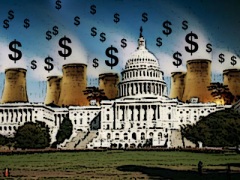By Luis R. Miranda
The Real Agenda
May 19, 2010
Pajamas Media has received a leaked internal assessment produced by Spain’s Zapatero administration. The assessment confirms th e key charges previously made by non-governmental Spanish experts in a damning report exposing the catastrophic economic failure of Spain’s “green economy” initiatives.
e key charges previously made by non-governmental Spanish experts in a damning report exposing the catastrophic economic failure of Spain’s “green economy” initiatives.
On eight separate occasions, President Barack Obama has referred to the “green economy” policies enacted by Spain as being the model for what he envisioned for America.
Later came the revelation that Obama administration senior Energy Department official Cathy Zoi — someone with serious publicized conflict of interest issues — demanded an urgent U.S. response to the damaging report from the non-governmental Spanish experts so as to protect the Obama administration’s plans.
Most recently, U.S. senators have introduced the vehicle for replicating Spain’s unfolding economic meltdown here, in the form of the “American Power Act.” For reasons that are obvious upon scrutiny, it should instead be called the American Power Grab Act.
But today’s leaked document reveals that even the socialist Spanish government now acknowledges the ruinous effects of green economic policy.
Unsurprisingly for a governmental take on a flagship program, the report takes pains to minimize the extent of the economic harm. Yet despite the soft-pedaling, the document reveals exactly why electricity rates “necessarily skyrocketed” in Spain, as did the public debt needed to underwrite the disaster. This internal assessment preceded the Zapatero administration’s recent acknowledgement that the “green economy” stunt must be abandoned, lest the experiment risk Spain becoming Greece.
The government report does not expressly confirm the highest-profile finding of the non-governmental report: that Spain’s “green economy” program cost the country 2.2 jobs for every job “created” by the state. However, the figures published in the government document indicate they arrived at a job-loss number even worse than the 2.2 figure from the independent study.
This document is not a public report. Spanish media has referred to its existence in recent weeks though, while Bloomberg and the Washington Examiner have noted the impact: Spain is now forced to jettison its plans — Obama’s model — for a “green economy.”
Remarkably, these items have received virtually no media attention.
An item which has been covered widely, however, is that President Obama is now pressuring Spain to turn off its spigot of public debt in the name of averting a situation similar to that of Greece.
Also covered widely is Obama’s promotion of the American Power Act — the legislation which would replicate Spain’s current situation in the United States.
Put simply, Obama is currently promoting a policy in the U.S. which is based on a policy that he wishes to see Spain abandon. Welcome to Obamaland, the particulars of which are explained in a fashion grandly more illuminating than this Obama-Zapatero dance in Power Grab: How Obama’s Green Policies Will Steal Your Freedom and Bankrupt America.
A translation of the leaked Zapatero government internal slide presentation: “Renewable Energy: Situation and Objectives April 2010”
1) Renewable Energy: Situation and Objectives April 2010
2) Renewable Energy Situation: The price of electricity affects household welfare
According to EuroStat data, the cost of electricity for households in Spain moved from below the European average to slightly above the average (+5% higher)
3) Renewable Energy Situation: The price of electricity determines the competitiveness of Spanish industry
Energy is a key input in industrial production processes. In basic industries (cement, industrial gases, metals, basic chemicals and steel), energy costs are three times the labor cost. The electrical cost for the Spanish industry is well above the European average (+17% higher).
4) Renewable Energy Situation: The price increase is mainly due to additional costs of renewables
The price of electricity determines the competitiveness of Spanish industry
Historical evolution of the prices of light and pool price [Appears above a graph showing a 77% price spike in industry's price for electricity]
A price increase cannot be explained by the evolution of electricity market price (pool), which has even fallen since 2005
5) Renewable Energy Situation: The price increase is mainly due to additional costs of renewables
The increase in the over-cost paid for renewable energy explains more than 120% of the variation of the electric bill, and has offset the reduction in production costs of conventional electricity (25%)
To these direct costs of renewables must be added indirect costs, as the need for additional investment in networks to integrate renewables (about 10% of planned investment in the planning) and capacity payments to the modular backup facilities (coal and gas) that are running a smaller number of hours
6) Situation of renewable energy: renewable energy has had a positive impact …
Thanks to the increase of renewable energies in the mix:
The rate of energy supply has increased by 3 points since 2005, to 23%, and the import of energy products has been reduced 5.500M Euro (including hydraulics).
Emissions have been reduced significantly, thanks primarily to the mix of electric generation being much cleaner (less than 120 tons of CO2 emissions per GWh of oil produced).
7) Situation of renewable energy: but its evolution in recent years has been too fast
From 2004-2010 the amount of premiums [over-cost paid for renewable energy; the subsidy] has increased fivefold. Only in 2009 it doubled over the previous year to reach 5.045M€, equivalent in amount to the entire public investment in R + D + i in Spain. [The renewables subsidy equaled the entire cost of producing electricity in Spain]. The forecast for 2010 is 6.300M€ (although 5.800M€ budgeted in January). This should add 1.000M€ for cogeneration.
With operational facilities, the renewable sector will receive in the next 25 years more than 126.000M€. In this factor, it adds a commitment to continue providing input to the renewable energies in the mix to meet the European objectives, which will increase this figure significantly.
8 ) Situation of renewable energy: Heterogeneity of renewables: costs
In 2009, the solar photovoltaic technology accounted for 53% of the extra cost of renewables, while they contributed only 11% of energy generated from these sources.
9) Situation of renewable energy: Heterogeneity of renewables: Impact on the external sector
Exports: Net exports of Spanish wind industry 1.300M€ contributed to the trade balance in 2008 and, besides, wind generation avoids fossil imports of 3.6M€.
Imports: By contrast, the PV industry growth was not gradual, hampering the formation of an auxiliary Spanish industry. In 2008 imports of photovoltaic cells and modules in Spain amounted to 5.182M€ (28.6% of net imports of crude and derivatives) as long around the 62% were imported.
10) Situation of renewable energy: Heterogeneity of renewables: Technical problems
Network Management. The proliferation of small plants and fluctuations in the availability of technologies hinder the management of the network.
11) Situation of renewable energy:
Regulatory mechanisms to support renewables have been:
– Pioneers in the world, which has allowed us to stay ahead of the industry, learn from the experience and finding some excesses.
There are numerous examples of these high returns: analyst reports, premiums accepted in other countries, over-subscription in the pre-records, facilities willing to accept lower premiums, “paper market” …
– Overly cautious about the ability of cost reduction technologies
– Inflexible, thereby preventing adjust remuneration to market signals and technological advancement
– Hardly told them by the administration in setting prices initially and have no control over the amounts … Which has caused a “bubble effect,” such as seen with photovoltaics in 2008 and the emergence of the thermal bubble (which would have continued in 2010 and successively had it not been for the pre-registration requirement imposed), as well as a sharp increase the over-costs [subsidies] paid to renewables in the form of a feed-in tariff.
12) Situation of renewable energy: Heterogeneity of renewables: International comparison
In wind power, our rates are in line with Europe. However, solar photovoltaics, Spanish retribution has been the most high, despite the higher number of hours of sun and more solar radiation.
Spain Wind € 75-84/MWh Solar €265/295/350/450/MWh
China Wind € 56-67 Solar € 121/MWh
Japan Wind € 73-89/MWh
Germany Wind € 92/MWh Solar € 287-395/MWh
France Wind € 82/MWh Solar €310-380
Italy Wind € 85/MWh Solar € 350-390
Poland Wind € 90/MWh
13) Situation of renewable energy: Recent technological developments
The investment costs of renewable energies mainly depend on its technological learning curve
The plots have experienced tremendous technological development in recent years, reducing their investment costs
Not being mature technologies, have much future room for improvement, which informs a decision to slow its current expansion
14) Situation of renewable energy: What have we done?
The Government has adapted the following initiatives:
– A new framework for PV in 2008 (RD1578/2008) that brings order to the pace of installation and marking signs ecstatic that transfer with May fast technological development gains to consumers
– Creation of a technology pre-registration for the remainder of May 2009 has allowed us to avoid the “bubble” that was generated in thermal and prevent the system being made even more untenable in 2010.
– Package of measures for the reduction to the tariff deficit with input from the traditional electric companies, consumers and government (without the contribution of renewable energy).
15) Situation of renewable energy: Difficulties in reducing the tariff deficit
– The Government is committed by law to eliminate by 2013 the tariff deficit
– Despite the evolution of the wholesale market (pool), the balance of certain items (the Iberian peninsula, nuclear waste) and higher light, the rate deficit was only slightly reduced.
16) Objectives
– Reaching 20% of final energy and 40% of electric generation from renewable sources by 2020.
– Reducing the deficit and preserve the competitiveness of industry and household welfare.
– Transfer gains in technological developments to consumers.
– Avoid speculation caused by excess profits, which damages its image and retards the construction of the plants pre-assigned (with an adverse effect on the industry).
– Mitigate the incentive for fraud that can generate the current differential between the rate and the price of the pool.
– Promote technological improvement and cost reduction, advancing the attainment of “grid parity,” which will allow greater installation of renewables until 2020.

 e key charges previously made by non-governmental Spanish experts in a damning report exposing the catastrophic economic failure of Spain’s “green economy” initiatives.
e key charges previously made by non-governmental Spanish experts in a damning report exposing the catastrophic economic failure of Spain’s “green economy” initiatives.